- What is Cataracts?
- Statistics
- Risk Factors
- Progression
- Symptoms
- Clinical Examination
- How is it Diagnosed
- Prognosis
- Treatment
- References
What is Cataracts?
Cataracts are the process by which the lens of the eye becomes cloudy or opaque. They are the leading cause of blindness and visual loss globally. Cataracts can be classified according to the:
|
Appearance and location of the opacity
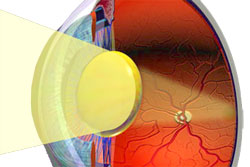
The appearance and location of the opacity within the lens is one method used to categorise cataracts. There are several different types of cataracts within this classification, including:
- Nuclear: Nuclear cataracts are the most common type in the aging lens and involve the central part of the lens.
- Cortical: Cortical cataracts involve the outer layer of the lens and are often associated with childhood cataracts.
- Capsular: Capsular cataracts result in clouding of the lens capsule, which is the bag that surrounds the lens of the eye.
- Posterior subcapsular: Posterior subcapsular cataracts result in clouding of the back part of the lens.
Level of maturity/progression
The level of maturity or progression is also used to classify cataracts. Within this classification are the following types:
- Immature: In an immature cataract, the lens has developed some opacities, but these are still separated by areas of normal, clear lens.
- Mature: Mature cataracts have progressed from immature, so that the entire lens is completely opaque and cloudy.
- Intumescent: In an intumescent cataract, the lens has become swollen and enlarged due to water being taken into the lens.
- Hypermature: Hypermature cataracts result when the lens and capsule become smaller and wrinkled due to the leakage of fluid out of the lens.
- Morgagnian: Morgagnian cataracts are hypermature cataracts in which the lens’ central portion sinks and becomes liquefied.
Cause
The cause of the cataract is also frequently used to classify them. Most commonly cataracts are related to increasing age but also occur in childhood. Cataracts may also be related to metabolic and nutritional abnormalities, drugs, trauma, radiation exposure and inflammation.
Statistics
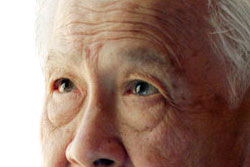
The overall prevalence of cortical cataracts in the urban Australian population is 11.3%.However, the number of people affected increases from about 4% of the population aged 50-59 years, to more than 60-70% of those aged 90 years and above.
The overall prevalence of nuclear cataracts in Australia is similar at approximately 11%, although there is an even greater increase in the frequency of nuclear cataracts compared to cortical cataracts as age increases, with 80-100% of those 90 years old being affected.
The risk of developing cataracts over a 10-year period in those over 49 years old is 36% for nuclear cataracts and 28% for cortical cataracts respectively. Of those people that develop cataracts, the average age for cataract surgery in Australia has been found to be 75.8 years and surgery in the second eye frequently follows soon after the first cataract operation.
The frequency of cataracts occurring in younger people within Australia is much less compared to age-related cataracts, occurring in 1 in 4,500 infants or children.
Risk Factors
A broad range of predisposing factors has been linked to the development of cataracts.
Demographic

- Age – the risk of developing cataracts strongly increases with age.
- Sex – women have been demonstrated to be at higher risk of developing cortical and nuclear cataracts then men.
- Ethnicity – African-American and Caribbean people experience higher rates of cortical cataracts than Caucasian people. Within Australia, Aboriginal Australians are three times more likely to experience vision loss due to cataracts than non-Aboriginal Australians.There is also evidence that the risk of developing cataracts is lower among those with higher education.
Diabetes
Diabetes is a well-established risk factor for cataracts. Diabetes has been shown to accelerate the formation and progression of age-related cataracts and also result in the development of cataracts in younger people.
This occurs because the lens in a person with diabetes takes up glucose, which is converted to a sugar substance, sorbitol. This substance is unable to diffuse through the lens and therefore results in an increased pressure within the lens. As a result, water moves into the lens and may cause lens swelling and clouding.Those who have had diabetes for more than 5 years are more likely to develop cataracts.
Other systemic conditions
In addition to diabetes, other diseases are also associated with cataracts. People with gout for greater than 10 years are at greater risk of developing cortical cataracts.
Individuals affected by Wilson’s disease are predisposed to developing cataracts because copper deposition on the cornea (Kayser-Fleisher rings) clouds the lens and a characteristic green sunflower type of cataract may be seen.
Low calcium may predispose a person to developing cataracts.
Galactosaemia is a condition where the body is unable to process the sugar galactose. It may result in development of cataracts soon after birth.
Chronic ultra-violet light exposure

Medications
Several medications are linked to the development of cataracts. In particular, steroids predispose a person to developing posterior cataracts and children are particularly sensitive to the effect of steroids.
There is also evidence that inhaled steroids for respiratory disease may contribute to a person developing cataracts.Topical beta-blockers used in other eye disease have been shown to be a risk factor for cataracts.
Genetics
There is evidence to suggest that there is a genetic predisposition towards the development of nuclear and cortical cataracts. However, whether this inheritance is due to a single gene or contributions from multiple genes is yet to be established. Future studies are necessary to gain a deeper understanding of the genetic predisposition to developing cataracts.
Trauma
Trauma is a relatively common predisposing factor for cataract development in younger people. The type of trauma that may result in opacification of the lens includes both penetrating injuries and blunt eye trauma, and the cataract may be associated with lens dislocation, bleeding and other eye injuries.
Other eye disease
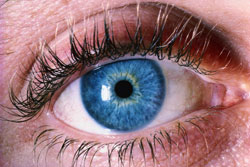
Other eye diseases that may predispose an individual to develop cataracts include retinitis pigmentosa, severe short-sightedness and glaucoma, of the closed angle type.
Ionising radiation
The effect of ionising radiation on the lens is recognised as a factor for the development of cataracts. Radiation, such as that from standard medical x-rays can cause direct changes in the lens’ cells resulting in clouding of the lens several years after the exposure.
Electric shocks from high voltage wires and infrared radiation in the glassblowing occupation are also associated with cataract development.
Congenital
Cataracts occurring in infants and children may be due to familial predisposition, infection when in the womb, eye disease or systemic disease.
Several of the more common disorders associated with sporadic cataracts in the Australian childhood population includes Down’s syndrome, Rubella embryopathy, aniridia, chronic juvenile arthritis with uveitis, diabetes and galactosaemia.
Alcohol and smoking

High levels of alcohol consumption also contribute to the development of cataracts.
Progression
In adults:
Cataracts are the leading cause of blindness in adults worldwide.If left untreated, the lens undergoes change from an immature cataract, to an intumescent cataract, until the entire lens is involved and it becomes a mature cataract.These changes are associated with progressive visual loss and an increasing impact on the individual and their life.
In children:
The natural history of childhood and infant cataracts is very dependent on the type of cataract present. Some childhood cataracts do not progress, some progress slowly and some progress more rapidly and have visually significant effects on the patient. If childhood cataracts are progressive and are left untreated, the visual outcomes are very poor as this is a stage when important visual development is occurring.
Symptoms
The symptoms an individual may experience depend on whether the cataracts involve one eye or both, the degree of the cataract and the position of the opacity within the lens.
If the cataract involves one eye only, then the individual may not notice the effects until the cataract has progressed. The person affected may describe difficulty reading, recognising faces, driving or watching television. They may describe worsening in vision in bright light particularly if the central part of the lens is clouded.
Some individuals may experience double vision and see haloes if the cataract is interfering with the passage of light rays to the back of the eye.
Occasionally, improved near-vision may be reported in the history, due to the cataract increasing the ability of the lens to bend the light and create a focused image.
An individual presenting with suspected cataracts should be questioned to assess whether any risk factors for cataracts are present including diabetes, eye disease, medications and smoking. The impact of the cataract on the individual’s quality of life should also be determined.
Clinical Examination
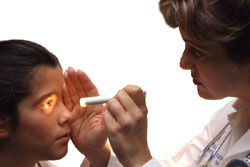
- External examination and eye movements: An external examination of the eye, eyelids and eye lashes should look for features that may alter the outcome post-surgery.
- Visual acuity and refraction: This is measured with the Snellen eye chart and if there is a reduction in visual acuity, a pinhole card is used to exclude short-sightedness as the cause of the vision loss.
- Testing for a relative afferent pupillary defect (RAPD): This is done by the swinging torch test, where a light is moved from one eye to another. If a RAPD is present, the pupil of the affected eye will dilate, rather then constricting when the light is shone into it. A cataract should not cause a RAPD and if one is present this may indicate an optic nerve problem.
- Ophthalmoscopy: This allows the ophthalmologist to visualise the retina, which is the area at the back of the eye.
- Pupil dilatation: Dilatation of the pupil is undertaken in order to visualise the red-eye reflex more easily and undertake a more thorough eye examination.
- Slit lamp examination: Examination with a slit-lamp allows the pattern and location of the cataract to be seen. The ophthalmologist looks in particular at the surface of the eye for any conditions that may complicate cataract surgery.
How is it Diagnosed
Age-related cataracts are diagnosed following a thorough history and physical examination, as described above. Therefore laboratory investigations are required as a routine part of the pre-operative work-up. Investigations for diabetes, hypertension and heart conditions may be performed and this may involve blood tests, an ECG and chest X-ray.
Imaging studies such as an ultrasound, CT or MRI may be required if a very dense cataract obscures an adequate view of the back of the eye.
Specific measurements are undertaken prior to the cataract operation in order to evaluate the eye and plan for an artificial lens implantation. This involves measuring the curvature and the length of the eye in order to calculate how strong the lens needs to be.
Prognosis

Treatment
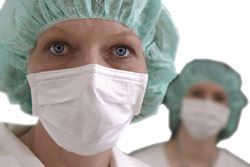
Whether cataract surgery is appropriate depends on the individual and the effect of the cataract on their vision and quality of life. Younger people with cataracts may chose to undergo surgery earlier on.
Surgery
Phacoemulsification surgery is now the standard method. This involves a small cut made in the front part of the eye. Through this hole a fine instrument is used to dissolve the hard lens and the dissolved lens is suctioned out. This whole process is called phacoemulsfication. A folded, artificial lens implant is then placed within the empty lens bag and allowed to unfold. Careful washing of the lens is undertaken in order to remove any left over lens matter. Often stitches are not required as the cut is so small and is therefore self-healing.
Extracapsular surgery used to be the most widely practiced method of surgery, prior to the phacoemulsification technique. It involves a larger cut and the entire cloudy lens is removed from the eye. A non-folding artificial lens is inserted and the cut is closed with stitches. This procedure is sometimes associated with problems in the wound closure.
Intracapsular surgery is now only used in special situations. It involves removal of the entire lens as well as the surrounding lens capsule.
For most individuals who undergo cataract surgery the procedure occurs under local anaesthetic unless there are specific conditions for which general anaesthetic may be more appropriate.
The artificial lens implanted within the lens capsule determines the final state of vision for the individual. Inserting an artificial lens allows any shortsightedness or longsightedness to be corrected during the cataract surgery. Once the operation is complete the new lens should last for the individual’s lifetime and no replacement or maintenance therapy is normally required.
Complications of surgery
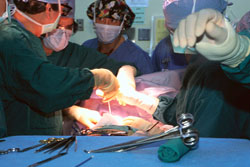
- Infection
- Bleeding
- Eye perforation
- Retinal detachment
- Decreased vision post-operatively
- Rupture of the posterior capsule
- Cystoid macular oedema
- Glaucoma
- Posterior capsular opacification, where the posterior part of the capsule becomes cloudy. This is a common reason for vision decline post-cataract surgery and may require a further laser procedure to correct this.
In order to avoid the complications associated with cataract surgery and to promote recovery it is recommended that 1-2 days rest occurs and heavy lifting is avoided for 2-3 weeks.
Prevention
Although many advances have been made in the surgical treatment of cataracts, there are currently no known effective preventative strategies.
However, there is evidence in the literature that smoking, whether current or in the past, increases the risk of developing cataracts. Alcohol consumption is also associated with a modest increase in cataract development, therefore this should be minimised.
Several vitamins, dietary supplements and antioxidants have been studied over the years, but the results have not provided definitive conclusions as to the effect of these on the development of cataracts.
References
- Cotran RS, Kumar V, Collins T. Robbins Pathologic Basis of Disease. 7th ed. Philadelphia: W.B. Saunders Company; 2004.
- Versace F. Cataract. Part 1: Causes, diagnosis and pre-operative testing. Modern Medicine. 1998; 96-106.
- McCarty CA, Mukesh BN, Fu CL, Taylor HR. The epidemiology of cataract in Australia. Am J Ophthalmol.1999 Oct; 128(4): 446-65.
- Kanthan GL, Wang JJ, Rochtchina E et al. Ten-year incidence of age-related cataract and cataract surgery in an older Australian population. The Blue Mountains Eye Study. Ophthalmology. 2008 May; 115 (5): 808-14.
- Wirth MG, Russell-Eggitt IM, Craig JE, Elder JE, Mackey DA. Aetiology of congenital and paediatric cataract in an Australian population. Br J Ophthalmol. 2002 July; 86(7): 782-6.
- West, S. Epidemiology of cataract: accomplishments over 25 years and future directions. Ophthalmic Epidemiol. 2007 Jul-Aug; 14(4): 173-8.
- Wearne S. Remote Indigenous Australians with cataracts: they are blind and still can’t see. MJA. 2007; 187(6): 353-6.
- West SK, Valmadrid CT.Epidemiology of risk factors for age-related cataract. Surv Ophthalmol. 1995; 39(4): 323-34
- National Cancer Control Initiative. The 2002 national non-melanoma skin cancer survey: a report by the NCCI Non-melanoma skin cancer working group [online]. Ed. M.P. Staples, 2003. Available from: [URL Link]
- Klein R, Klein BE, Jensen SC, Moss SE, Cruikshanks KJ. The relation of socioeconomic factors to age-related cataract, maculopathy, and impaired vision. The Beaver Dam Eye Study. Ophthalmology. 1994; 101(12): 1969-79.
- Amaya L, Taylor D, Russel-Eggitt I, Nischal KK, Lengyel D. The morphology and natural history of childhood cataracts. Surv Ophthalmol. 2003; 48(2): 125-44.
- Khaw PT, Shah P, Elkington R. ABC of Eyes. 4th ed. London: BMJ Publishing Group Ltd; 2004.
- Versace F. Cataract. Part 2: Surgical Treatment. Modern Medicine. 1998; 30-9.
- Tan JS, Wang JJ, Younan C, Cumming RG, Rochtchina E, Mitchell P. Smoking and the long-term incidence of cataract: the Blue Mountains Eye Study. Ophthalmic Epidemiol. 2008; 15(3): 155-61.
- Lindblad BE, Hakansson N, Philipson B, Wolk A. Alcohol consumption and risk of cataract extraction: a prospective cohort study of women. Ophthalmology. 2007; 114(4): 680-5.
- The Cancer Council Queensland, Schools Sun Smart Policy Guidelines, 2007. Available from: [PDF File]
All content and media on the HealthEngine Blog is created and published online for informational purposes only. It is not intended to be a substitute for professional medical advice and should not be relied on as health or personal advice. Always seek the guidance of your doctor or other qualified health professional with any questions you may have regarding your health or a medical condition. Never disregard the advice of a medical professional, or delay in seeking it because of something you have read on this Website. If you think you may have a medical emergency, call your doctor, go to the nearest hospital emergency department, or call the emergency services immediately.







